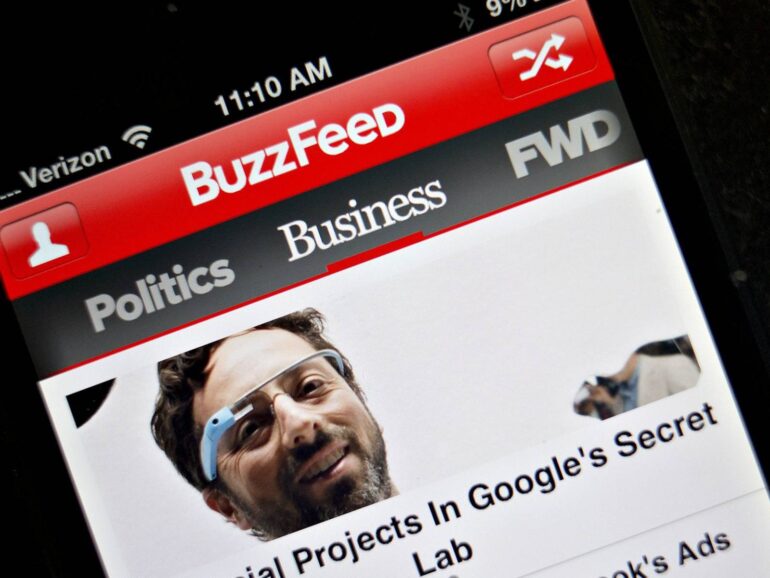TL;DR:
- BuzzFeed has faced declining ad revenue since going public in 2021.
- Q3 saw a 35% YoY drop in ad revenue, but organizational changes led to a small profit.
- Key sectors like CPG, entertainment, and tech show soft spending, while retail spending grows modestly.
- BuzzFeed aims to retain user engagement by focusing on generative AI games, creator networks and prioritizing news content.
- Despite shutting down BuzzFeed News, HuffPost experienced a successful Q3 in terms of homepage traffic.
- Generative AI games drive 60% more traffic but don’t generate enough sponsored content opportunities.
- Content revenue dropped 32% YoY due to decreased demand for sponsored content.
- BuzzFeed is optimistic about sponsorships through the First We Feast brand.
- Commerce revenue dropped 3% YoY but remains resilient due to the partnership with Amazon.
- Short-form video challenges and competition have led to a 19% YoY drop in time spent on BuzzFeed’s platforms.
- BuzzFeed is shifting its focus to selling short-form videos directly to advertisers and emphasizing long-form content for user engagement.
Main AI News:
BuzzFeed, a digital media giant, finds itself navigating the turbulent waters of the digital media landscape. Since going public at the end of 2021, the company has witnessed a steady decline in ad revenue, exacerbated by stiff competition among major social media players and the surge in short-form video content.
In a recent Q3 earnings call, BuzzFeed CEO Jonah Peretti acknowledged the dwindling traffic referrals from major platforms. These platforms prioritize their own vertical video formats, intensifying the competition for audience share and directly impacting BuzzFeed’s ability to monetize its content. Consequently, Q3 saw a sharp 35% year-over-year decline in ad revenue, plummeting from $50 million to $33 million.
Despite these challenges, organizational restructuring and layoffs in the company contributed to a small Q3 profit, resulting in a positive $3 million in adjusted EBITDA.
However, the picture remains bleak for BuzzFeed’s ad revenue. Key sectors such as CPG, entertainment, financial services, and tech continue to show soft spending, while retail spending registers only modest growth, according to BuzzFeed President Marcela Martin.
To adapt to this changing landscape, Peretti outlined a strategy focused on retaining user engagement on BuzzFeed’s owned and operated sites and apps. This strategy involves doubling down on generative AI games, expanding the creator network, and giving priority to news content for HuffPost.
Surprisingly, BuzzFeed’s renewed emphasis on news content seems to be paying off, with Q3 being HuffPost’s most successful quarter in terms of homepage traffic since its acquisition by BuzzFeed in February 2021.
Generative AI games, exemplified by the success of “Nepogotchi,” have proven to be a winner for BuzzFeed, driving 60% more traffic compared to non-AI content. Engagement with generative AI content has also seen double-digit growth compared to Q2.
However, despite the success of generative AI, sponsored content opportunities have not kept pace, resulting in a 32% year-over-year decline in content revenue, dropping from $38 million to $26 million. Contributing to this decline was the impact of strikes by organizations like WGA and SAG-AFTRA, which affected the availability of dollars from movie and TV tie-ins.
Peretti expressed optimism in BuzzFeed’s ability to secure sponsorships through the First We Feast brand, particularly its popular show “Hot Ones,” where celebrities are interviewed while consuming increasingly spicy chicken wings. BuzzFeed’s acquisition of First We Feast in 2021, while reportedly in talks to sell Complex Media, indicates its commitment to maintaining First We Feast as a cornerstone of its long-form video portfolio.
BuzzFeed’s commerce revenue experienced a 3% year-over-year drop to $14 million, yet it remains the company’s most resilient revenue stream, thanks in large part to its long-term partnership with Amazon. In pursuit of further growth, BuzzFeed is actively exploring additional e-commerce opportunities, including expanding its CPG product offerings like the recently launched “Hot Ones” Hot Pockets.
The proliferation of short-form video and intensified competition among social media platforms, vying for audience attention against TikTok, have posed significant challenges to BuzzFeed’s monetization efforts. These efforts have resulted in a 19% year-over-year drop in time spent on BuzzFeed’s platforms. While BuzzFeed has expanded its short-form video offerings, Peretti acknowledged that shorter videos are harder to monetize compared to longer-form content, and platforms are less inclined to share short-form video revenue with publishers.
In response, BuzzFeed is shifting its focus towards selling short-form video content directly to advertisers. Moreover, Peretti believes that users are seeking deeper engagement with long-form media, highlighting the importance of gen AI games and longer-form video content as better strategies to increase time spent on BuzzFeed’s platforms.
Nevertheless, Peretti cautioned that these new initiatives will require time to scale and offset the challenges reflected in the company’s financial performance. BuzzFeed remains committed to evolving and thriving in the ever-changing digital media landscape.
Conclusion:
BuzzFeed’s struggle with declining ad revenue and challenges in short-form video monetization reflect the shifting dynamics of the digital media market. To remain competitive, BuzzFeed is diversifying its content strategy, emphasizing generative AI games and long-form content while seeking new sponsorship opportunities. This highlights the need for digital media companies to adapt and innovate to thrive in a changing landscape where user engagement and revenue generation pose ongoing challenges.

